
Organic Fouling
The following cleaning procedure is designed specifically for a system that has been fouled with organic species such as humic and fulvic acids, antiscalants, or oils.
The following cleaning procedure is designed specifically for a system that has been fouled with organic species such as humic and fulvic acids, antiscalants, or oils.
Cleaning Procedure
There are eight steps in cleaning elements fouled with organics, but the six steps are conducted first with a high pH cleaning solution and then repeated with a low pH cleaning solution. .
- Make up the desired high pH cleaning solution selected Table .
- Introduction of the cleaning solution.
- Recycle the cleaning solution for 30 minutes. If a color change occurs, dispose of the cleaning solution and prepare a fresh solution.
- Soak. For lightly scaled systems, a soak time of 1-2 hours is sufficient. Severely scaled systems can also be recovered with extended soak times. Severely scaled elements should be soaked individually outside of the pressure vessel in a vertical position. Check pH and adjust as required, or replace cleaning solution.
- Soak.
- High-flow pumping.
- Flush out.
- Repeat steps 2 through 6 with cleaning solution of HCl at pH 2.
- Restart.
Additional Information
If the organic fouling is the result of overfeeding of a coagulant used for feed water pretreatment, reversing the order of the cleaners can be more effective. To determine the proper order of the cleaning solutions (high pH followed by low pH or vice versa), try to gather a sample of the organic foulant from your system. With the sample, try treating it with caustic and then acid and vice versa to determine qualitatively which order of cleaning solution treatment dissolves the foulant better. If both treatments appear to work equally, it is usually better to clean with the high pH solution first.
For maximum effectiveness, the temperature of the cleaning solutions must be above 25°C. Elevating the temperature of the cleaning solution will assist in organic removal from the membrane surface. Some organics such as oils are very difficult to remove. To remove them, experiment with different soak times for optimum effectiveness. In addition, the most effective cleaning solution usually contains a surfactant such as Na-DDS or perhaps some commercially available membrane cleaners containing surfactants or detergents that can help remove the oils. Consult your chemical supplier for their recommendation.
Cleaning chemical formula in order used: NaOH is sodium hydroxide; HCl is hydrochloric acid (muriatic acid); Na-DDS is sodium salt of dodecylsulfate; sodium laurel sulfate; Na4EDTA is the tetrasodium salt of ethylene diamine tetraacetic acid and is available from The Dow Chemical Company under the trademark VERSENE 100 and VERSENE 220 crystals.
Table Organic fouling cleaning solutions
Cleaning solutions |
Solution |
Preferred |
0.1 wt % NaOH pH 12, 30°C maximum, followed by: 0.2% HCl pH 2, 45°C maximum |
Preferred |
0.1 wt % NaOH 0.025 wt % Na-DDS pH 12, 30°C maximum, followed by: 0.2% HCl pH 2, 45°C maximum |
Alternate |
0.1 wt % NaOH 1.0 wt % Na4EDTA pH 12, 30°C maximum, followed by: 0.2% HCl pH 2, 45°C maximum |
If the organic fouling is the result of overfeeding of a coagulant used for feed water pretreatment, reversing the order of the cleaners can be more effective. To determine the proper order of the cleaning solutions (high pH followed by low pH or vice versa), try to gather a sample of the organic foulant from your system. With the sample, try treating it with caustic and then acid and vice versa to determine qualitatively which order of cleaning solution treatment dissolves the foulant better. If both treatments appear to work equally, it is usually better to clean with the high pH solution first.

